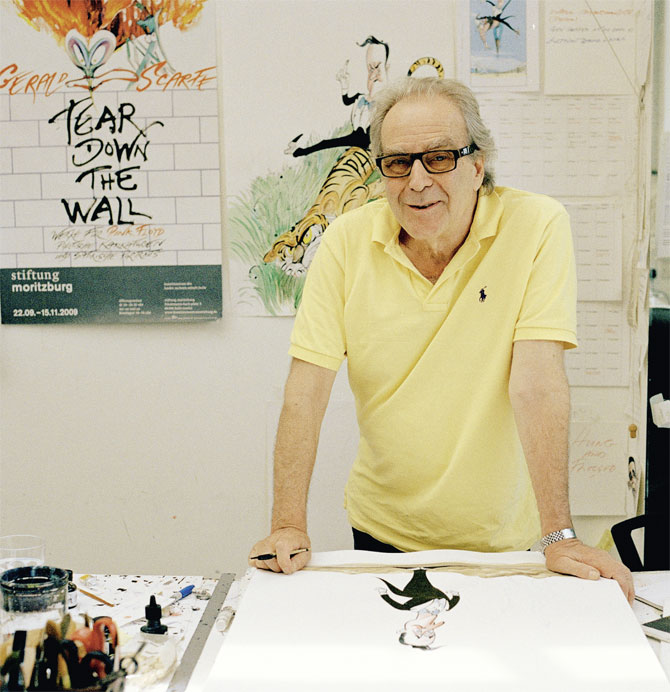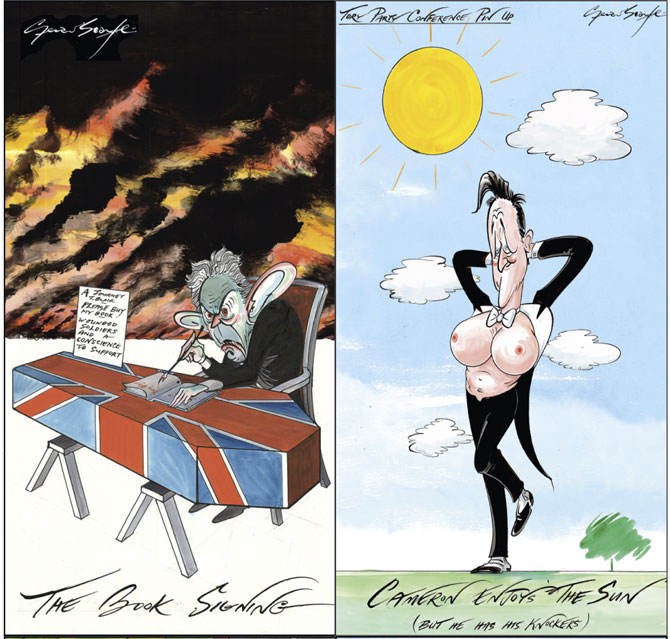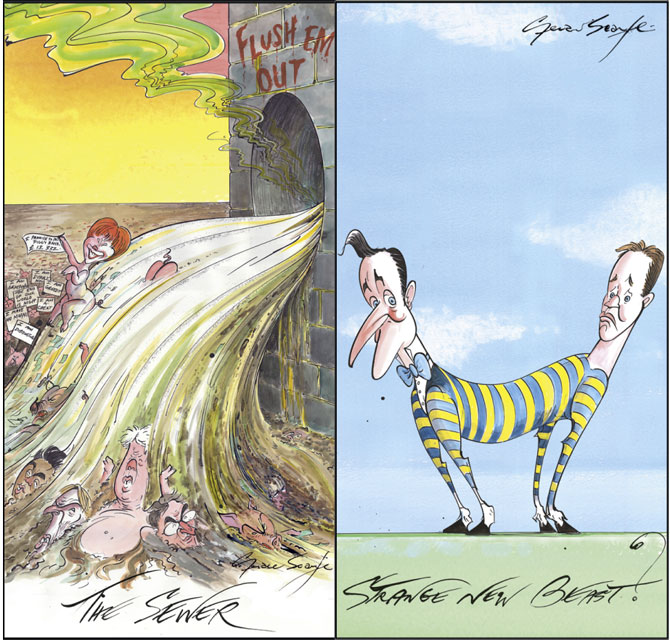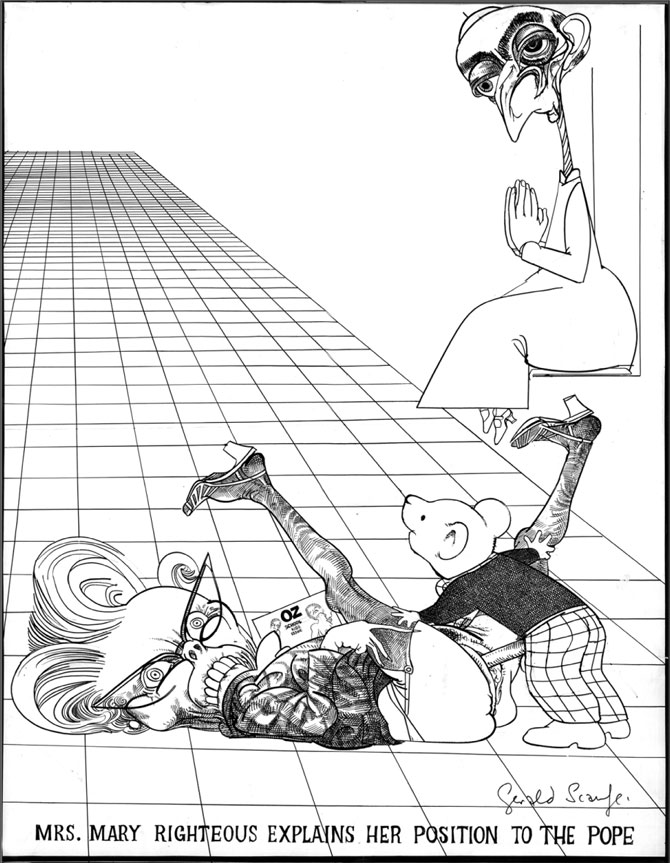WORDS BY CHRIS O’NEILLPHOTO BY MICHAEL OTERO, IMAGES COURTESY OF GERALD SCARFE Gerald Scarfe is the English illustrator and artist who is pretty much solely responsible for the existence of those scratchy caricatures flanking serious political commentary in your newspaper. You know, the ones that mean you don’t have to read a single word of text in order to perfectly grasp whatever pressing issue your broadsheet has decided you should feel strongly about on any given day. They also have the added bonus of making deadly boring situations appear funny and interesting.If you don’t read newspapers, then you may know Scarfe as the guy whose 1971 animated film,A Long Drawn-Out Trip, with its trippy, amorphous visuals and cut-and-paste soundtrack, brought stream-of-consciousness art into the worlds of film and music, and earned him a breakthrough job directing the animation in Pink Floyd’s 1982 filmThe Wall. What’s more, in 1998, his caricatures of comics such as Tommy Cooper and Peter Cook appeared on a set of postage stamps commemorating British comedians.Now 74 years of age, Scarfe looks like he leads a gloriously happy life. He draws, drinks tea, and plays with his grandchildren in an intimidatingly grand Chelsea home that was previously owned by former prime minister David Lloyd George. Perhaps those are the rewards to be reaped from spending a childhood bedridden with chronic asthma, as Scarfe did, leading him to do little else but practise drawing for ten years.Vice: Did you ever think you could have such a prolonged and successful career essentially just taking the piss out of politicians?Gerald Scarfe:Not really. It’s a dodgy job and I’m surprised that one can achieve such notoriety from such a small area. But I also do more than just politics. Politics can be crushingly boring and I certainly get bored drawing the same silly buggers over and over again. I’m glad Gordon Brown is gone. He was so, so dull. It’s very difficult to make an interesting caricature out of an uninteresting person.Do you ever feel bad about the people you draw?No. Most of the people in power are arrogant bastards, thinking they know the way to lead us. It’s kind of a game to them. It means they’ve arrived so they welcome any attention. They end up wanting the pictures to hang on their wall.Are you ever tempted to do something so disgusting that they won’t want to hang it on the wall?Well, I try. But of course, it depends how disgusting. In a national newspaper you can’t draw them covered in shit. I’d love to draw that sort of thing and I do draw them for myself. I can print them when I come to release a book. There’s a lot more freedom when printing a book.
Gerald Scarfe is the English illustrator and artist who is pretty much solely responsible for the existence of those scratchy caricatures flanking serious political commentary in your newspaper. You know, the ones that mean you don’t have to read a single word of text in order to perfectly grasp whatever pressing issue your broadsheet has decided you should feel strongly about on any given day. They also have the added bonus of making deadly boring situations appear funny and interesting.If you don’t read newspapers, then you may know Scarfe as the guy whose 1971 animated film,A Long Drawn-Out Trip, with its trippy, amorphous visuals and cut-and-paste soundtrack, brought stream-of-consciousness art into the worlds of film and music, and earned him a breakthrough job directing the animation in Pink Floyd’s 1982 filmThe Wall. What’s more, in 1998, his caricatures of comics such as Tommy Cooper and Peter Cook appeared on a set of postage stamps commemorating British comedians.Now 74 years of age, Scarfe looks like he leads a gloriously happy life. He draws, drinks tea, and plays with his grandchildren in an intimidatingly grand Chelsea home that was previously owned by former prime minister David Lloyd George. Perhaps those are the rewards to be reaped from spending a childhood bedridden with chronic asthma, as Scarfe did, leading him to do little else but practise drawing for ten years.Vice: Did you ever think you could have such a prolonged and successful career essentially just taking the piss out of politicians?Gerald Scarfe:Not really. It’s a dodgy job and I’m surprised that one can achieve such notoriety from such a small area. But I also do more than just politics. Politics can be crushingly boring and I certainly get bored drawing the same silly buggers over and over again. I’m glad Gordon Brown is gone. He was so, so dull. It’s very difficult to make an interesting caricature out of an uninteresting person.Do you ever feel bad about the people you draw?No. Most of the people in power are arrogant bastards, thinking they know the way to lead us. It’s kind of a game to them. It means they’ve arrived so they welcome any attention. They end up wanting the pictures to hang on their wall.Are you ever tempted to do something so disgusting that they won’t want to hang it on the wall?Well, I try. But of course, it depends how disgusting. In a national newspaper you can’t draw them covered in shit. I’d love to draw that sort of thing and I do draw them for myself. I can print them when I come to release a book. There’s a lot more freedom when printing a book. You get a lot of licence when drawing a cartoon, more than, say, a stand-up comedian might have.Yes, it’s very hard to sue a cartoon. There’s a story that Tony Blair was very upset by a cartoon he saw in one of the dailies and said, “I’m going to sue that bugger.” But Alistair Campbell warned him, “You can’t do that, you’ll look like a nutter.” It’s only a silly little cartoon. They’re supposed to be busy leading countries, not getting bothered by small, scratchy cartoons.Have you ever had legal trouble?Yes, and unbelievably the drawing’s now in the Tate! It’s a cartoon of Mary Whitehouse I made for a student magazine called Ink. At the time there was a magazine called Oz and they did an issue called the Schoolkids Issue; it had some sexually explicit things in it. Mary Whitehouse complained about Oz and went so far as to go and see the Pope about the state of morals in Britain in the early 70s.What’s she doing in the cartoon?I should say, the underground symbol for students at the time was, for some reason, Rupert Bear. And in the issue of Oz there was something like Rupert Bear with a huge willy. So I did a picture on the subject, called “Mrs Mary Righteous Explains Her Position to the Pope”, with Mary Whitehouse spread-eagled on the floor and Rupert Bear with this huge cock, screwing her. And now it’s in the Tate! She sued for that. I think the magazine paid £200 to a charity to make it go away.What else were you doing at that time?I’ve worked at theSunday Timessince 1967.Private Eyebefore that,Timemagazine and also theDaily Mail—but only for a year.The Daily Mail?Don’t get me wrong, I hate theDaily Mail—it’s trash, although they are very good at writing for a particular market—but in my defence, at the time it was under a new editor who tried to radicalise it from the right to the centre left. He brought me in fromPrivate Eye. There was an auction between theDaily MailandDaily Expressfor me. They gave me a Jaguar E-Type but ended up sending me to Vietnam, because they couldn’t think what else to do with me. I couldn’t do my scurrilousPrivate Eyestuff in theDaily Mail.They bought me at enormous cost and couldn’t find anything for me to do.
You get a lot of licence when drawing a cartoon, more than, say, a stand-up comedian might have.Yes, it’s very hard to sue a cartoon. There’s a story that Tony Blair was very upset by a cartoon he saw in one of the dailies and said, “I’m going to sue that bugger.” But Alistair Campbell warned him, “You can’t do that, you’ll look like a nutter.” It’s only a silly little cartoon. They’re supposed to be busy leading countries, not getting bothered by small, scratchy cartoons.Have you ever had legal trouble?Yes, and unbelievably the drawing’s now in the Tate! It’s a cartoon of Mary Whitehouse I made for a student magazine called Ink. At the time there was a magazine called Oz and they did an issue called the Schoolkids Issue; it had some sexually explicit things in it. Mary Whitehouse complained about Oz and went so far as to go and see the Pope about the state of morals in Britain in the early 70s.What’s she doing in the cartoon?I should say, the underground symbol for students at the time was, for some reason, Rupert Bear. And in the issue of Oz there was something like Rupert Bear with a huge willy. So I did a picture on the subject, called “Mrs Mary Righteous Explains Her Position to the Pope”, with Mary Whitehouse spread-eagled on the floor and Rupert Bear with this huge cock, screwing her. And now it’s in the Tate! She sued for that. I think the magazine paid £200 to a charity to make it go away.What else were you doing at that time?I’ve worked at theSunday Timessince 1967.Private Eyebefore that,Timemagazine and also theDaily Mail—but only for a year.The Daily Mail?Don’t get me wrong, I hate theDaily Mail—it’s trash, although they are very good at writing for a particular market—but in my defence, at the time it was under a new editor who tried to radicalise it from the right to the centre left. He brought me in fromPrivate Eye. There was an auction between theDaily MailandDaily Expressfor me. They gave me a Jaguar E-Type but ended up sending me to Vietnam, because they couldn’t think what else to do with me. I couldn’t do my scurrilousPrivate Eyestuff in theDaily Mail.They bought me at enormous cost and couldn’t find anything for me to do. It seems odd sending a cartoonist to Vietnam. What were you meant to do there?It was weird but when I got to the war it politicised me. It was a horrific thing. There was one instance where I saw some American construction workers in a bar, which must have been a brothel, although I didn’t realise it at the time. Horrid, horrid people, these construction workers, profiting from misery. So I drew the horrible situation in this bar, with this sweet Vietnamese girl taking a huge American upstairs, and the same scene in the back. They didn’t print that. I insisted on drawing in the morgue. It hadn’t struck me that when people are blown up in war, they’re just like lumps of meat. Some have no heads, others no legs, some just split down the middle. And there were medics in white coats, cleaning them up, completely immune to it. I couldn’t draw a thing.Was that before you went to LA and made A Long Drawn-Out Trip?I guess it was. That was ’66. I made the film there in 1970. Despite Vietnam, I’ve had a long romance with America and even though I hated a lot of their presidents, I do love Obama. He seems like a good liberal guy. I’m praying nothing happens to him. I always draw him as Superman because so much is expected of him, but just recently I’ve been drawing him with a few holes in his cape.How did A Long Drawn-Out Trip come about?The BBC sent me to Los Angeles to work with a new animation technique that supposedly filled in “in between” cells of animations for you, cutting down on work immensely. When I got there it was complete cobblers, of course it didn’t—it just dissolved between images, melting through from one position to the next. But since I’d been flown there I decided to draw to make the best of it. I drew everything American I could think at the time—Coca-Cola, Mickey Mouse, Playboy, Black Power symbols—and then made a film of the images dissolving into each other.It comes across as very trippy and drug-fuelled.I suppose it does. I was never a druggy myself, apart from a few mild episodes with Pink Floyd. There were quite a lot of drugs around at that time so I drew Mickey Mouse smoking a spliff and so on. At the time, I was just doing it for fun and didn’t think it was particularly revolutionary. But when the guys from Pink Floyd saw it they thought I was fucking mad and wanted me to work with them. Funnily enough, years later I worked as production designer on Disney’sHerculesfilm. When they saw my drawings of Mickey with his spliff an audible gasp went around Disney. It was a bit of a shock for them.
It seems odd sending a cartoonist to Vietnam. What were you meant to do there?It was weird but when I got to the war it politicised me. It was a horrific thing. There was one instance where I saw some American construction workers in a bar, which must have been a brothel, although I didn’t realise it at the time. Horrid, horrid people, these construction workers, profiting from misery. So I drew the horrible situation in this bar, with this sweet Vietnamese girl taking a huge American upstairs, and the same scene in the back. They didn’t print that. I insisted on drawing in the morgue. It hadn’t struck me that when people are blown up in war, they’re just like lumps of meat. Some have no heads, others no legs, some just split down the middle. And there were medics in white coats, cleaning them up, completely immune to it. I couldn’t draw a thing.Was that before you went to LA and made A Long Drawn-Out Trip?I guess it was. That was ’66. I made the film there in 1970. Despite Vietnam, I’ve had a long romance with America and even though I hated a lot of their presidents, I do love Obama. He seems like a good liberal guy. I’m praying nothing happens to him. I always draw him as Superman because so much is expected of him, but just recently I’ve been drawing him with a few holes in his cape.How did A Long Drawn-Out Trip come about?The BBC sent me to Los Angeles to work with a new animation technique that supposedly filled in “in between” cells of animations for you, cutting down on work immensely. When I got there it was complete cobblers, of course it didn’t—it just dissolved between images, melting through from one position to the next. But since I’d been flown there I decided to draw to make the best of it. I drew everything American I could think at the time—Coca-Cola, Mickey Mouse, Playboy, Black Power symbols—and then made a film of the images dissolving into each other.It comes across as very trippy and drug-fuelled.I suppose it does. I was never a druggy myself, apart from a few mild episodes with Pink Floyd. There were quite a lot of drugs around at that time so I drew Mickey Mouse smoking a spliff and so on. At the time, I was just doing it for fun and didn’t think it was particularly revolutionary. But when the guys from Pink Floyd saw it they thought I was fucking mad and wanted me to work with them. Funnily enough, years later I worked as production designer on Disney’sHerculesfilm. When they saw my drawings of Mickey with his spliff an audible gasp went around Disney. It was a bit of a shock for them. One of your most famous creations is the hammer logo from The Wall.Yes, I was worried when I was drawing that logo about it becoming adopted by far-right groups. During the rally scene we filmed, a lot of skinheads came from Tilbury or somewhere like that, and some had shaved hammers into their hair. A guy sent me an email just a year ago, he’d got the crossed hammers tattooed on the top of his arm and I was slightly worried. Some people don’t get the idea of parody.Your drawings have also been shocking in their time.Shock is very important, although it’s getting increasingly hard to do it. Back in the 60s I was apparently one of only a few people doing this stuff. Everything else was so bland, people didn’t say anything wrong. It was only when the so-called satire movement started in the 60s that one began to find inPrivate Eyeyou could say anything you liked and get away with it.Does anything shock you now?What does shock me is that I am used to seeing men urinating in the streets. I’m still not quite used to seeing woman urinating in the streets just yet, but we all have our boundaries.
One of your most famous creations is the hammer logo from The Wall.Yes, I was worried when I was drawing that logo about it becoming adopted by far-right groups. During the rally scene we filmed, a lot of skinheads came from Tilbury or somewhere like that, and some had shaved hammers into their hair. A guy sent me an email just a year ago, he’d got the crossed hammers tattooed on the top of his arm and I was slightly worried. Some people don’t get the idea of parody.Your drawings have also been shocking in their time.Shock is very important, although it’s getting increasingly hard to do it. Back in the 60s I was apparently one of only a few people doing this stuff. Everything else was so bland, people didn’t say anything wrong. It was only when the so-called satire movement started in the 60s that one began to find inPrivate Eyeyou could say anything you liked and get away with it.Does anything shock you now?What does shock me is that I am used to seeing men urinating in the streets. I’m still not quite used to seeing woman urinating in the streets just yet, but we all have our boundaries.

Advertisement
Advertisement

Advertisement

Advertisement
Advertisement
